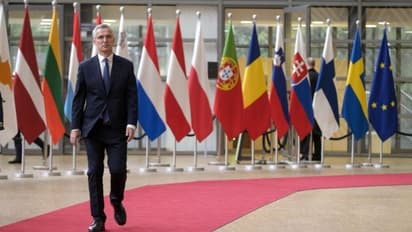NATO options after 'Russian' missile strike on Poland

Synopsis
If confirmed that the missile was indeed fired upon by the Russians, NATO could go ahead and invoke Articles 4 and 5 of its charter.
The missile -- believed to have been fired from Russia -- that claimed the lives of two people in Poland, a North Atlantic Treaty Organisation member State, could see the power bloc invoking Article 5 of its charter.
After the rocket fell on Przewodow village in eastern Poland, near the border with Ukraine, Secretary General Jens Stoltenberg said that NATO allies are monitoring the situation and in close consultation. "Important that all facts are established," Stoltenberg said after speaking to his Polish counterpart Andrzej Duda and expressing his deep condolences for the loss of life.
Also read: G20 Summit: Top leaders consider call for 'end of war' amid Russian invasion
To note, Poland is home to one of eight NATO multinational battlegroups. The battlegroups are combat-ready and operate alongside other NATO member states through conducting exercises and vigilance activities. Their presence is indicative that an attack on a NATO ally will be treated as an attack on the entire alliance.
Poland is yet to officially confirm that the missile was fired by Russia. Duda told media persons, 'We do not have unequivocal evidence of who fired the missile. A probe is underway. It was most probably Russian-made.' US President Joe Biden offered his Polish counterpart full support to Poland and its investigation into the "explosion".
If confirmed that the Russians indeed fired the missile, NATO could go ahead and invoke Articles 4 and 5 of its charter.
What are Articles 4 and 5?
Article 4 states that the Member States would get into a huddle when the political independence, territorial integrity or security of any of the parties is threatened.
Article 5 goes a step further. It states that if a NATO ally faces an armed attack, all other Member States shall treat it as an armed attack against all of them and take the actions necessary to assist the ally who was attacked.
While exercising the right of individual or collective self-defence as mentioned in Article 51 of the Charter of the United Nations, each member State will assist the ally by taking action as it deems necessary. That includes the use of armed force to maintain and restore the North Atlantic region's security. The assistance is not limited to military assets but also the material resources of each country.
Thereafter, any response -- armed or otherwise -- needs to be reported immediately to the Security Council. Any measures taken will be terminated when the Security Council has taken the measures necessary to restore international peace.
When was Article 5 first invoked?
Article 5 was first invoked 24 hours after the September 11, 2001, World Trade Centre bombings in the United States. At the request of the United States, NATO launched Operation Eagle Assist. From mid-October 2001 till mid-May 2002, NATO airborne early warning and control radar aircraft patrolled US airspace. That operation over 360 sorties involving 830 crew members from 13 NATO nations.
Besides, on October 26, NATO also launched operation Active Endeavour, in which some elements of NATO's standing naval forces patrolled the Mediterranean and monitored shipping routes to detect terrorist activity, including illegal trafficking.
Also Read: Game theory decodes Chinese motives behind incursions into India
Check the Breaking News Today and Latest News from across India and around the world. Stay updated with the latest World News and global developments from politics to economy and current affairs. Get in-depth coverage of China News, Europe News, Pakistan News, and South Asia News, along with top headlines from the UK and US. Follow expert analysis, international trends, and breaking updates from around the globe. Download the Asianet News Official App from the Android Play Store and iPhone App Store for accurate and timely news updates anytime, anywhere.